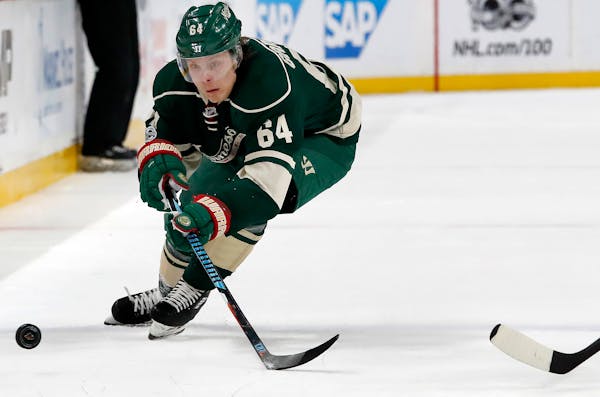The Wild's maddeningly dumb early season schedule — during which Minnesota will play exactly twice during the 12 days spanning Oct. 8 to Oct. 19 and included one stretch of four off days between games and another stretch (currently ongoing) of five off days — has at least carried with it a silver lining: It gave the Wild, ravaged by injuries to its forwards, a chance to heal and avoid hitting the ice with less-experienced players.
The bad news, though, is that after playing only four games so far this year — everyone else in the Wild's division has already played at least six times — the schedule is about to accelerate to a much faster pace. And there's no guarantee any of the five key missing Wild forwards will be back for the start of that stretch Friday. There's a good chance a few of the best forwards, in fact, will see their missed games start piling up in a hurry. For a team that started the season 1-2-1 as those injuries mounted, that's troubling.
Starting Friday at Winnipeg, the Wild will play 21 times in 42 days — once every other night. That's not an unreasonable pace, but it is one that will test their depth in multiple ways. To that end, here's what we know about their five injured forwards at this point:
*Marcus Foligno, who suffered a facial fracture during his fight last week in Chicago, seems to have the best chance of returning to the lineup Friday in Winnipeg. Head coach Bruce Boudreau said Foligno, who didn't practice Tuesday, should practice Thursday after the Wild's off day Wednesday. If that goes well, Foligno — who has already skated on a few different line combinations when he was healthy — could play against the Jets.
*Mikael Granlund could also return, but that seems more like wishful thinking than Foligno's return. Granlund has been nursing a groin injury and hasn't played since the opener Oct. 5. Even if Granlund doesn't make it back Friday or Saturday (Calgary is the second of the back-to-back games), he should be back soon. So that's relatively good news. But that's where the good news ends.
*Charlie Coyle broke his right fibula against Chicago last Thursday and was expected to miss 6-8 weeks from the time of the injury. If he misses seven weeks, right in the middle of that estimate, it would keep him out through November and this entire stretch of 21 games in 42 days.
*Nino Niederreiter sprained his ankle last week against Chicago, and it was announced at the time that he'd miss a minimum of three weeks. If he came back exactly three weeks after the injury, he'd still miss the rest of October and the six games remaining this month. If it lingered any longer, he'd miss a bunch more — the Wild plays five times in the first nine days of November. It was a high ankle sprain, which can be finicky.
*That brings us to the big unknown: Zach Parise's injury. He hasn't played yet this season and suffered a "setback" at Monday's practice and is scheduled to see his doctor Wednesday. That type of meeting can bring reassurance that Parise should turn the corner soon or definitive news that this could be a long-term problem. When you've been around sports and read enough about injuries, though, you know a setback or re-aggravation is never a good thing. We haven't seen Vikings QB Sam Bradford on the field, for instance, since his knee flared up again during an awful first half comeback attempt in Chicago. At the very least, the Wild can't count on Parise being on the ice any time soon.
In the mean time, Minnesota is so tight against the cap that it's shuffling reinforcements back and forth between Iowa and Minnesota during long stretches without games. Assistant coach Darby Hendrickson has had to skate during the last two practices just so the Wild could fill three forward lines, let alone four.
In the short term, the Wild has actually held up pretty well in the face of all this adversity. Three of those injuries happened during the Chicago game, when the Wild managed its only win of the season. Minnesota at least grabbed a point in its home opener against Columbus with all five of those players missing, losing in overtime after leading much of the game.
But a suddenly faster-paced schedule will test the Wild's depth, exposing less-heralded players to bigger roles more often. The temptation might be to tighten up and try to win some 2-1 and 3-2 games given the relative health of the Wild's defensemen and goalies, but that can be a challenge even when everyone is healthy.
If Minnesota can at least tread water while waiting for some of these key players to return — by the end of November, the season will be 25 games old — and avoid more attrition in the mean time, the Wild should still be in good shape for the season.
If losses start to mount, though, it could create the kind of hole that either exhausts the Wild as it digs its way out and into the playoffs or causes Minnesota to miss the postseason altogether. For a team with Stanley Cup aspirations, games in October and November are suddenly far more meaningful than we might have imagined just a couple weeks ago.
Movie Review: Prepare to get hot and bothered with stylish, synthy tennis drama 'Challengers'
Havertz scores 2 as Arsenal routs Chelsea 5-0 to cement Premier League lead
Defensemen injuries are already piling up early in the NHL playoffs
Analysis: The IndyCar season has just started but free agency is in full swing after only 2 races

